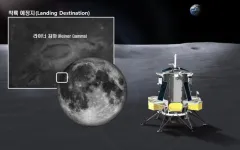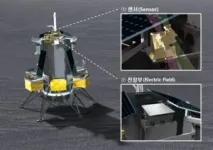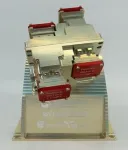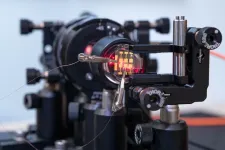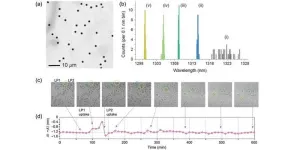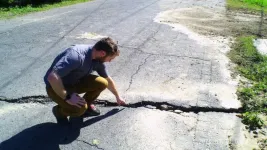(Press-News.org) The Ministry of Science and ICT (Minister Jong-Ho Lee, hereinafter referred to as 'MSIT') and the Korea Astronomy and Space Science Institute (Director Young-Deuk Park, hereinafter referred to as 'KASI') announced the beginning of the transfer of the lunar space environment monitor, 'LUSEM'(Lunar Space Environment Monitor) that will be aboard United States’ unmanned lunar lander in 2024, has began on September 4th.
LUSEM is a payload developed by the Korea Astronomy and Space Science Institute (KASI) in participation with the U.S. NASA's CLPS(Commercial Lunar Payload Services) initiative as an international lunar exploration and research collaboration. The CLPS initiative is a subset of the U.S. Artemis program, led by NASA, which aims to launch unmanned lunar landers every year to carry payloads related to scientific exploration and commercial development of the Moon. NASA is responsible for project planning and management. Contractors selected through bidding are responsible for developing, launching, landing, and operating the unmanned lunar landers. KASI plans to develop four scientific payloads* to be carried on the lander, contributing to collaborative lunar scientific exploration missions.
* ① LUnar Space Environment Monitor (LUSEM), ② Lunar Surface MAGnetometer (LSMAG), ③ Lunar Regolith-grain Camera (GrainCams), ④ Lunar Vehicle RADiation Dosimeter (LVRAD)
LUSEM is a scientific payload developed by KASI in collaboration with Professor Jongho Seon's research team (Dept. of Astronomy and Space Science at Kyung Hee University). It is equipped with a sensor capable of detecting high-energy particles with energies of 50 kilo-electronvolts (50 keV) and above. The development was undertaken in partnership with the domestic company Satrec Initiative, which was responsible for manufacturing.
Unlike the Earth's surface, the lunar surface lacks protection from an atmosphere or magnetic field making high-energy particles from deep space to be directly detected. These high-energy particles can have implications for the health of astronauts, the functionality of spacecraft electronics, and the structural integrity of space vehicles. Moreover, they are essential for scientific research into phenomena like space weathering on celestial bodies devoid of atmosphere. Due to these reasons, the importance of studying high-energy particles has consistently been highlighted, as they play a crucial role in future manned deep-space exploration and space science research.
Based on this necessity, NASA announced in November 2021 that LUSEM of Korea will be aboard the Intuitive Machines' unmanned lunar lander, Nova-C, scheduled for launch in 2024. The Nova-C lander will land on the low-latitude "Reiner Gamma" region on the lunar near side. Its mission will encompass a range of tasks, including space environment observation through LUSEM, surface terrain observation, local magnetic field measurements, deployment of small cooperative autonomous rovers for exploration, and deployment of laser retroreflectors.
LUSEM consists of a sensor unit, an electronic box, and connecting harnesses. Among them, the sensor unit is the main equipment for observing high-energy particles, composed of two solid-state telescopes (SST) that enable bidirectional observations – one pointing upwards and the other downwards. Each pair of SST detects either electrons or ions. The sensors facing upward detect particles coming from space, while the ones facing downward detect particles reflected from the lunar surface. By analyzing the differences between these two measurements, valuable insights are gained. The electronic box controls the sensor unit, processes signals, supplies power, and so on.
On September 4th, after packaging for air transportation, LUSEM embarks on its journey to the United States. It will onboard a vibration-free vehicle to be transferred from Daejeon to Incheon International Airport, then transferred to Intuitive Machines of Housten, Texas by air. Subsequently, KASI will integrate LUSEM into Nova-C by early 2024 under the oversight of NASA and will conduct launch preparation Activities including the interface and functionality tests with the lander with the goal of launching in late 2024 using Falcon-9 of Space X.
Cho Sun-hak, Director General of the Space, Nuclear and Big Science Policy Bureau at the Ministry of Science and ICT, commented, "As the first collaborative project launched after signing the Artemis Agreement, its successful progression is of immense significance." He further added, "Following the achievements of Danauri, this continuous collaboration between South Korea and the United States in the field of space exploration is truly heartening. We will strive to expand our nation's participation scope within the Artemis program and further extend the horizon of international space collaborative research."
Park Young-Deuk, the Director of the KASI, remarked, "LUSEM stands as a source of pride among our nation's remarkable scientific payloads." He expressed optimism, saying, "We anticipate that LUSEM will provide a wealth of information about the space environment crucial for the era of space exploration."
END
Korean Scientific payload for observing the lunar space environment begins its transfer to the US for the scheduled 2024 launch
To observe the space environment landing on the low-latitude Reiner Gamma region on the near side of the Moon
2023-09-04
ELSE PRESS RELEASES FROM THIS DATE:
IOP Publishing appoints Dr. David Gevaux as Chief Editor of Reports on Progress in Physics
2023-09-04
IOP Publishing (IOPP) has appointed Dr. David Gevaux as the first Chief Editor of Reports on Progress in Physics. Taking up the post from the 4th of September, Dr. Gevaux will lead on ambitious plans for the journal, as its scope expands to include groundbreaking new research content alongside the authoritative reviews for which it is well known across all areas of physics.
Working closely with Professor Subir Sachdev, the Editor in Chief of Reports on Progress in Physics, Dr. Gevaux will champion the editorial ...
New study uncovers the Causes of the Qing Dynasty's Collapse
2023-09-04
The Qing Dynasty in China, after over 250 years, crumbled in 1912. Led by the Complexity Science Hub (CSH), an international research team has pinpointed key reasons behind the collapse, revealing parallels to modern instability and offering vital lessons for the future.
China is considered today to be the world's largest economy (in terms of PPP). However, this position is not new. In 1820, China's economy already held the top spot, accounting for 32.9% of the global GDP. In the interim, there was a period of decline followed by a resurgence. In 1912, after over 250 years in power, the Qing Dynasty collapsed despite being considerably wealthier at the time ...
New genes and natural toxins offer hope for cancer patients unresponsive to chemotherapy
2023-09-04
Scientists from Queen Mary University of London have discovered two new genes that cause head and neck cancer patients to be resistant to chemotherapy, and that silencing either gene can make cancer cells previously unresponsive to chemotherapy subsequently respond to it.
The two genes discovered actively ‘work’ in most human cancer types, meaning the findings could potentially extend to other cancers with elevated levels of the genes.
The researchers also looked through a chemical library, commonly used for drug discovery, and found two substances that could target the two genes specifically and make resistant cancer cells almost 30 times more sensitive to ...
Better cybersecurity with new material
2023-09-04
Digital information exchange can be safer, cheaper and more environmentally friendly with the help of a new type of random number generator for encryption developed at Linköping University, Sweden. The researchers behind the study believe that the new technology paves the way for a new type of quantum communication.
In an increasingly connected world, cybersecurity is becoming increasingly important to protect not just the individual, but also, for example, national infrastructure and banking systems. And there is an ongoing race between hackers and those trying to protect information. The most common way ...
People with lung conditions face extra risks from climate change
2023-09-04
People living with lung conditions, such as asthma and chronic obstructive pulmonary disease (COPD), face even greater risks from climate change, according to an expert report published today (Monday) in the European Respiratory Journal [1].
The report brings together evidence on how the effects of climate change, such as heatwaves, wildfires and flooding, will exacerbate breathing difficulties for millions of people around the world, particularly babies, young children and the elderly.
On behalf of the European Respiratory Society, which represents more than 30,000 lung specialists from 160 countries, the authors ...
ChatGPT is debunking myths on social media around vaccine safety, say experts
2023-09-04
ChatGPT could help to increase vaccine uptake by debunking myths around jab safety, say the authors of a study published in the peer-reviewed journal Human Vaccines and Immunotherapeutics.
The researchers asked the artificial intelligence (AI) chatbot the top 50 most frequently-asked Covid-19 vaccine questions. They included queries based on myths and fake stories such as the vaccine causing Long Covid.
Results show that ChatGPT scored nine out of 10 on average for accuracy. The rest of the time it was correct but left some gaps in the information provided, according to the study.
Based on these findings, experts who led the study from the GenPoB research group based ...
Growing evidence supporting the protein leverage hypothesis
2023-09-04
Humans, like many other species, regulate protein intake more strongly than any other dietary component and so if protein is diluted there is a compensatory increase in food intake. The hypothesis proposes that the dilution of protein in modern-day diets by fat and carbohydrate-rich processed foods is driving increased energy intake as the body seeks to satisfy its natural protein drive - eating unnecessary calories until it does so.
This paper, resulting from the Royal Society Discussion Meeting held in London last October, shows that observational, experimental and mechanistic research increasingly supports ...
Why breast cancer survivors don't take their medication, and what can be done
2023-09-02
For roughly 80% of breast cancer survivors, treatment doesn’t end with surgery, radiation and chemotherapy. Instead, for the next five to 10 years, doctors recommend that they take medication to block sex hormones, which can fuel tumor growth and spark recurrence.
The drugs are life-saving: They’ve been shown to cut risk of cancer recurrence by as much as half in patients with hormone receptor-positive tumors (HR+)—the most common form of breast cancer. Yet despite their promised benefits, 40% of patients stop taking them early and a third ...
New scalable, etching-based technique for precise tuning of microdisk lasers
2023-09-02
Micro- and nanodisk lasers have recently emerged as promising optical sources and probes for various applications in the fields of nanophotonics and biomedicine. Their ability to achieve lasing at a deterministic wavelength and ultra-narrowband precision is critical for several applications in on-chip photonic communications, on-chip bioimaging, biochemical sensing, and quantum photonic information processing. However, the large-scale fabrication of such precise wavelength micro- and nanodisk lasers remains challenging. Current nanofabrication processes introduce randomness in ...
Seismologists use deep learning for improved earthquake forecasting
2023-09-02
For more than 30 years, the models that researchers and government agencies use to forecast earthquake aftershocks have remained largely unchanged. While these older models work well with limited data, they struggle with the huge seismology datasets that are now available.
To address this limitation, a team of researchers at the University of California, Santa Cruz and the Technical University of Munich created a new model that uses deep learning to forecast aftershocks: the Recurrent Earthquake foreCAST (RECAST). In a paper published today in Geophysical Research Letters, the scientists show how the deep learning model is more flexible ...
LAST 30 PRESS RELEASES:
Dramatic rise in young people using mental health services
Be careful trusting TikTok for gout advice
A study by the University of Seville links the vanishing of the specific heats at absolute zero with the principle of entropy increase
Anxiety and insomnia may lower natural killer cell count, potentially repressing immune function
How parasitic, asexual plants evolve and live
Research spotlight: A subset of patients with depression could benefit from anti-inflammatory treatment
New fully digital design paves the way for scalable probabilistic computing
Membrane electrode assembly design for high-efficiency anion exchange membrane water electrolysis
U.S. debt ceiling disputes show measurable impact on global crude oil markets
Climate extremes triggered rare coral disease and mass mortality on the Great Barrier Reef
Direct observation reveals “two-in-one” roles of plasma turbulence
Humans rank between meerkats and beavers in monogamy ‘league table’
US fossil reveals early mass-burial event and ancient microbial attack
Sedative choice could improve outcomes for breathing tube patients
New superconducting thin film for quantum computer chips
Simulations reveal protein "dynamin" constricts cell membranes by loosening its grip
Nearly 1 in 5 UK emergency department patients cared for in corridors/waiting rooms
Heavy energy drink intake may pose serious stroke risk, doctors warn
Violence against women and children among top health threats: New global study reveals disease burden far larger than previously estimated
Predicting who is at risk of developing type 1 diabetes, as new drugs now available
New gene-mapping method unlocks hidden drivers of cancer
Ocean current and seabed shape influence warm water circulation under ice shelves
Call to increase funding for ‘invisible’ Deaf victim-survivors of domestic abuse
University of Maryland School of Medicine names distinguished scientist and academic leader Gerald M. Wilson, PhD, as Chair of the Department of Biochemistry and Molecular Biology
Receptors in mammary glands make livestock and humans inviting hosts for avian flu
Icy hot plasmas
Treating adults with autism: Maryland Clinical Center offers national blueprint for care after pediatric transition
University of Phoenix College of Doctoral Studies releases white paper on reclaiming control to build workforce resilience
NCCN Summit seeks to improve care for veterans and first responders with cancer from line-of-duty exposure
ERC Consolidator Grant for soft robotics researcher
[Press-News.org] Korean Scientific payload for observing the lunar space environment begins its transfer to the US for the scheduled 2024 launchTo observe the space environment landing on the low-latitude Reiner Gamma region on the near side of the Moon
